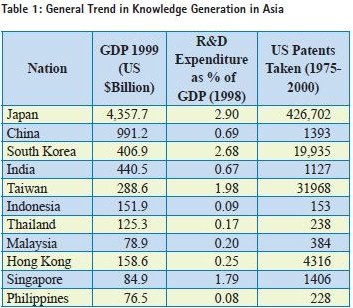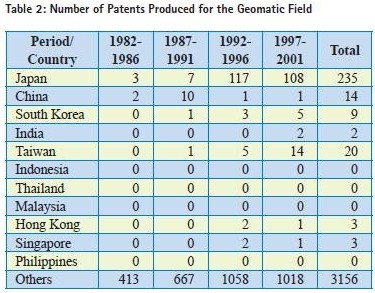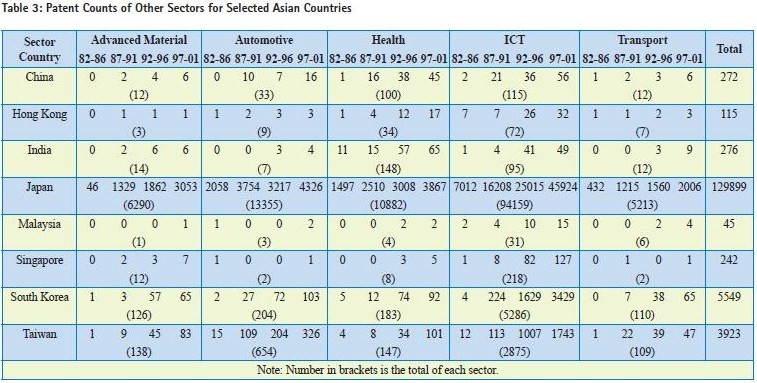| Education | |
GNSS education in Asia Pacific: Miles to go
General trends in geomatic knowledge generation
It is well known fact that the innovative activity which, is the primary source of knowledge generation, concentrated only in a number of developed nations. Within these developed nations, these activities are only concentrated and dominated by only a small number of corporations.
In developing nations, the primary mode of promoting technology advances is through technology acquisition. However, in this new era of economy, the focus is on innovation and the creation of new technology and higher value added activities by increasing basic and applied research. Malaysia, for example in the early years of its development has placed its primary emphasis on technology acquisition. As its per capita income increases, Malaysia is putting in place major fundamental research & development programs in the public and private sectors in an attempt to attain world leadership in key areas.
Table 1 shows two indicators of innovative activity for key Asian nations. These two indicators cover both knowledge ‘inputs’ as well as ‘output’. R&D expenditures are considered the ‘input’ indicator of the innovative activity. The knowledge output indicator considered in this study is patents obtained by inventors from different nations at the US Patent and Trademark Office over the past 25 years period (1975-2000). There are other forms of knowledge generation activities such as copyright and trade secret. However, because patenting is the primary form of intellectual property protection, patent data are considered to be the most available, objective and qualitative measure of knowledge output. Thus, a nation’s patenting activity is an indicator of the strength of its research enterprise and technological strengths, both overall and in particular fields of technology.
The table reveals that an extreme form of knowledge generation concentration with just three nations of Asia, which account for the bulk of all innovative activities in Asia. This top three nation’s of Asia, that is Japan, Taiwan and South Korea account for as much as 80% of Asia resources spent on R&D activity annually. In terms of knowledge output, the same top three nations have the most number of patents issued. They account nearly 98% of the knowledge output in terms of patents taken out in the US. Hence, the concentration in terms of knowledge output is even more uneven than for the knowledge inputs. But the obvious trend is that the control over knowledge is directly related to the amount of fund allocated to its R&D. Malaysia for example, allocated only 0.20% of its GDP for R&D purposes and this is reflected in the number of patents awarded for the past 25 year period, which amounted to only a meager 384 patents. The trend shows that Japan is way ahead in their innovation activities with a total of 426, 702 patents issued to them.
Besides the patenting activity defined by a nation of the inventor in all type of sectors, trends were also analyzed by the number of patents issued that are related to the Geomatic field. Keywords related to this field such as GPS, GNSS, mapping, remote sensing, triangulation, spatial, and photogrammetry are among others that are used in the definition. Table 2 shows the number of patents produced for the Geomatic field for a period from 1982 to 2001.
Table 2 shows that Japan still leads in their patenting activities with a total of 235 Geomatic patents issued for the 20- year period. And this is followed by South Korea, Taiwan and China. Out of the total 3442 Geomatic patents issued by the U.S. Patent and Trademark Office, only 286 or 8% originates from the Asian countries. The remainder of the 92% of the patents mostly originates either from North America or Europe. The numbers shows that there is lack of innovative activities amongst the Geomatic professionals in the Asian region compared to their North American or European counterparts. What is more disturbing is that Malaysia, which boasted four higher education institutions (UTM, UPM, UiTM and USM) that offered Geomatic program does not possessed a single patent in the Geomatic sector. Ironically Singapore, which the number of Geomatic professionals is far less than that of Malaysia has already produced three patents that are related to the Geomatic sector.
To make a definitive comparison on the innovation activities of Geomatic sector to other sectors, data for five different sectors are compiled and tabulated for selected Asian nations. The sectors concerned are Advanced Materials, Automotive, Health, ICT and Transport. Table 3 shows the patents count of major Asian nations. The table is based on the indicators computed for the same four five-year periods: 1982-1986, 1987- 1991, 1992-1996 and 1997-2001.
The table shows that Japan leads in all sectors in terms of the number of patents issued. But the technological capabilities of Korea and Taiwan are budding, with their growing strength most evident in the advanced materials and ICT sectors. In the transportation sector, Korea and Taiwan are showing steadily growing strength. On the other sides, three Asian nations of Malaysia, Hong Kong and Singapore do not have enough patenting activities in any of these five sectors to be identified as emerging competitors. Singapore for example allocated nearly 1.79 % of its GDP for R&D purposes and these percentage points is comparable to Korea or Taiwan, but still lags behind. The most probable reason for this trend is that these three nations lack what is called the indigenous R&D capability. For the most part, manufacturing and industrial development are currently supported by R&D done elsewhere.
Comparing the number of patents generated by Geomatic professionals with the other five sectors shows a very disturbing trend. Lets take Japan for example, leaders both in the number of Geomatic patents and number of all types of patents for Asian nation. For the 20-year period, Japan has produced a total of 235 patents related to Geomatic sector. Among the fi ve sectors, transport shows the least number of patents produced that is 5213 patents. Therefore, when compared to the weakest link of the fi ve sectors, Geomatic still pale behind considering the number of patents produced. Even though Malaysia does not produce a single patent in Geomatic fi eld, but all the other fi ve sectors have some form of innovative activities in terms of the number of patents. The problem of lack of innovative activity is not only confi ned to Malaysia alone, but also to all other Asian nations as shown both in Table 2 and 3. The lack of innovative activities it seems is not confi ned to a particular nation but to the Geomatic professionals itself.
Conclusions
Looking at the dismal performance of Geomatic professionals in terms of innovative activities in most part of Asian and Malaysia in particular, is it there is something that holding up these professionals from doing so? With our universities and numerous polytechnics offering Geomatic program, more is expected from them. Is it a problem of lack or inadequacy of skills? Or is it these professionals are too busy and being narrowly focused on doing something else?
Malaysian business are generally doing well, in large measure, as a result of our national investments in science and technology, and the innovation and competitiveness they yield. In this perpetual marathon that is global competition, now is the appropriate time to strengthen our effort into bringing the Geomatic fi eld to greater heights.
References
* Post Graduate Prospectus, 2003/2004. Faculty of Geoinformation Science and Engineering, Universiti Teknologi Malaysia, 100 pp.
*F. Walter, 2002. Use and Applications of Global Navigation Satellite Systems: forum on education and training. Paper presented at the UN/ USA International Meeting of Experts the Use and Applications of Global Navigation Satellite Systems, 11- 15 November, Vienna, Austria.
*C. Merry, 2002. GNSS education and training (with special emphasis on Developing Countries). Paper presented at the UN/USA International Meeting of Experts the Use and Applications of Global Navigation Satellite Systems, 11-15 November, Vienna, Austria.
*F. Walter, 2003.Report of the Working Group on Training, Education and Awareness Increase. Report presented at the Joint Meeting of Action Team on Global Navigation Satellite Systems and Global Navigation Satellite Systems Experts of UN/ USA Regional Workshops and International Meeting 2001-2002 8- 12 December, Vienna, Austria.
*United States Patent Offi ce, 2004. Report on Patents Submission Trends. Washington, USA.
My Coordinates |
EDITORIAL |
|
His Coordinates |
DATO’ DR ABDUL KADIR BIN TAIB |
|
News |
INDUSTRY | LBS | GPS | GIS | GALILEO UPDATE |
|
Mark your calendar |
FEBRUARY 2006 to NOVEMBER 2006 |
Pages: 1 2















 (No Ratings Yet)
(No Ratings Yet)





Leave your response!